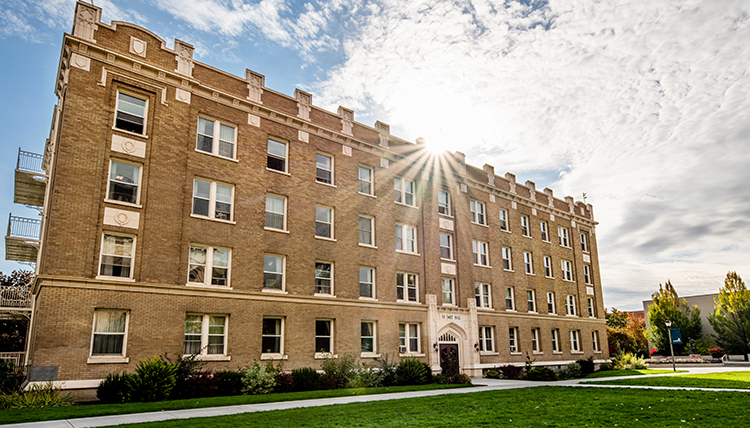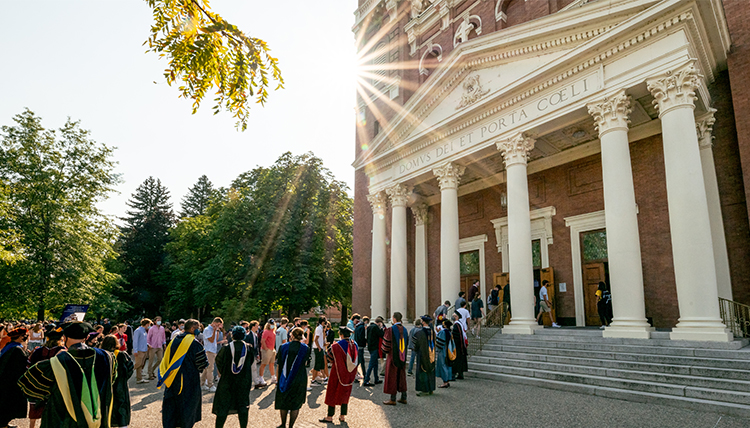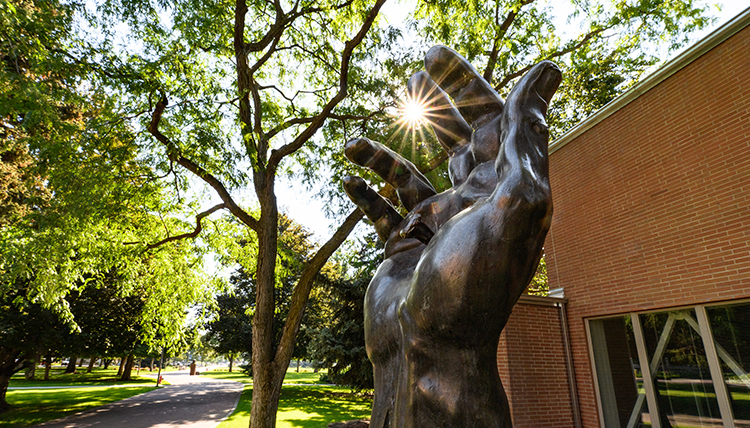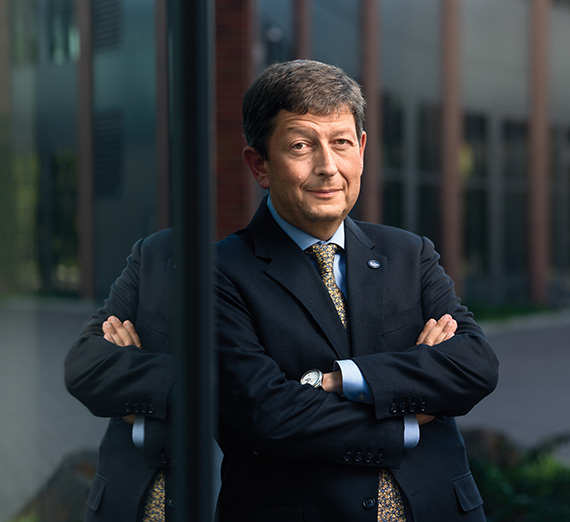Lighting the Way
A Feature from the 2021-22 Report of the President
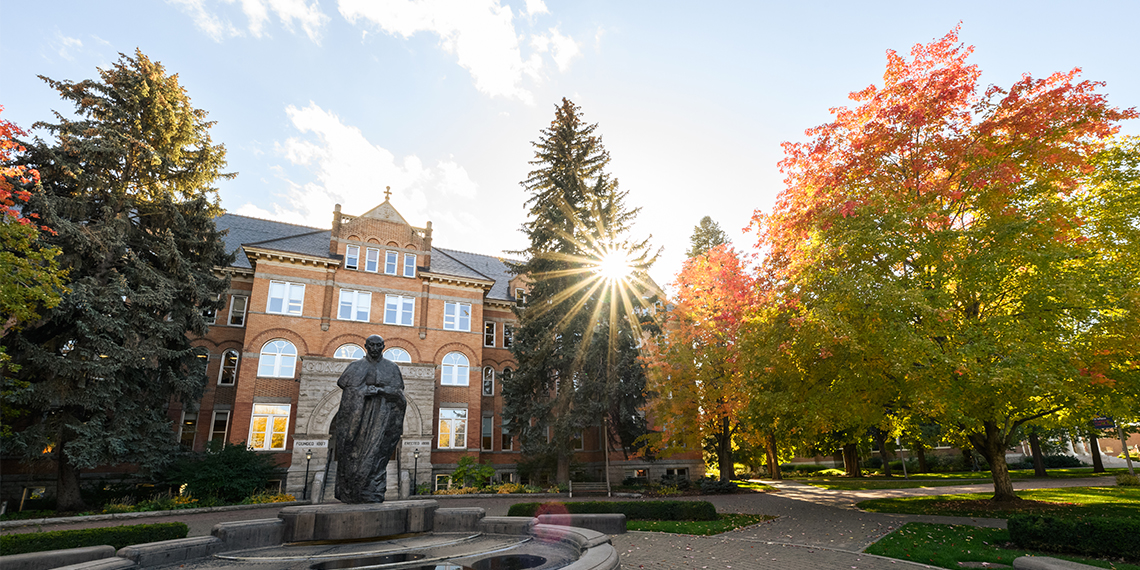
"Gonzaga is a light in the darkness,”
a student told President Thayne McCulloh.
It was a poignant encounter amid the complexities of returning to campus: The COVID-19 pandemic continued its disorienting progression, national conversations on higher education emphasized rising costs and student debt, and cultural shifts and demographic changes added to the questioning of higher ed as we know it.
How can higher ed remain relevant to a changing societal structure that no longer expects its entire workforce to show up in person to get the job done? Are universities actually helping to address real-world needs? Is a college education worth the expense?
McCulloh reflected on those questions with the student’s “light in the darkness” comment echoing in the background. “I believe with every fiber of my being that the perseverance of our students is all we need as testament that we are worth the investment,” he told Gonzaga faculty and staff this fall. Through a message of gratitude, renewal and opportunity, he galvanized a hopeful future made possible by discernment and strategic planning.
The first step into the future is revitalizing the University’s strategic plan to clarify how Gonzaga will bolster its relevance and viability while remaining true to its mission as a Catholic, Jesuit, humanistic institution. In the pages ahead, learn how the University will continue providing academic excellence and preparing students for lives of leadership and service while also addressing the significant challenges in the higher ed space today.
Situational Analysis: The Data
- Over the past decade, college enrollment in the U.S. has declined by 12.3%. (National Student Clearinghouse Research Center)
- Looking back to 2017 and ahead to 2027, enrollment in degree- granting postsecondary institutions will level off or slightly decline in the traditional 18- to 24-year-old population while increasing among 25- to 29-year-olds. (Institute of Education Sciences National Center for Education Statistics; fig. 15)
- Enrollment among white students will decrease, while enrollment among Black, Hispanic and Asian/Pacific Islander students will increase, with the largest growth (14%) expected from the Hispanic community. (Institute of Education Sciences National Center for Education Statistics)
- Inside Higher Education, in 2021, cited new realities that colleges and universities must embrace to remain relevant. Among them, “abandoning traditional practice, rejecting time- and place-based education, emphasizing digital, offering pioneering subject matters and certifications” and “generating revenue through things like continuing education and micro-credentials in place of degrees.”
Sharpening the Vision
Seven years ago Gonzaga University developed a community-driven strategic plan framed in the context of four commitments:
- Foster Responsibility for Shared Mission
- Animate Academic Excellence across the Institution
- Provide an Integrative Jesuit Educational Experience for Students
- Optimize Institutional Stewardship and Sustainability
President McCulloh began the 2022 academic year with a message to faculty and staff about the ways this plan has animated the University during a dynamic period in its history: “It affirms and defines our mission of Catholic, Jesuit and humanistic education, and articulates a vision as ‘a premier liberal-arts based university, recognized nationally for providing an exemplary Jesuit education that empowers its graduates to lead, shape and serve their chosen fields and the communities to which they belong.’ ”
Many of the actionable goals in the strategic plan have been accomplished, he noted: record-high graduation rates; launching compelling degree programs; continued progress in the diversity of our students; building the Della Strada Jesuit residence; completing the John and Joan Bollier Family Center for Integrated Science and Engineering; creating the Myrtle Woldson Performing Arts Center; dedicating new space for the humanities; and ongoing strength in intercollegiate athletics.
“In light of our progress, but also given the social and economic disruption catalyzed by the pandemic, now it is time to ask ‘What’s next?’ It is time to update our plan for the next five to seven years. We will not deviate from the mission, commitments and strategic objectives laid out in the current plan, which have served as an effective north star,” McCulloh said.
Strategic Planning
Guiding the revision of the strategic plan was top of the priority list when Sacha Kopp joined GU as provost in summer 2022, bringing with him extensive experience in public higher education coupled with a passion for mission-based work. Launching a discovery process called The Grand Challenge, Kopp has asked faculty and staff to submit proposals for actionable items related to five areas: academic scholarship, research and creative work; holistic student development; faculty and staff development and retention; sustainability of environmental and operational resources; and new degrees, certificates and credentials.
“What aggressive goals will we seek and what will make us current in 2030 that we didn’t know in 2010?” he asked.
“Economic access will be key,” he said, along with “providing a different set of support services for transfer students, adult learners and professionals.”
Nearly every sector – from business and government to education, technology and health care – is looking at how to build and engage the workforce through professional development. “Certification programs are more needed now than ever,” Kopp said. “Companies are developing learning certificate programs for their employees. Why not us? A foundation for this is already in place through the School of Leadership Studies; we simply need to build more and provide the credentials professionals are seeking.”
And yet, as vital as economic access and program innovation are, Kopp believes Gonzaga’s biggest challenge and opportunity is its mission.
“We have to renew our commitment to mission every day,” he said. “Our mission includes a commitment to social justice, living and learning in community, development of the whole person, as well as how we attend to spiritual, health and social development within an academic institution. It also involves critical inquiry by those who ask hard questions of their community and society.”
“One of our biggest accomplishments going forward will be to develop a renewed mission focus as a team,” Kopp said. Ellen Maccarone, associate professor of philosophy and former faculty adviser to the president, is acting vice president of the Office of Mission Integration, which has continued to bolster faculty and staff mission formation programming.
Housing Solutions
It has been 13 years since new housing became available on Gonzaga’s campus, with Coughlin Hall opening in 2009. In that time, enrollment has grown, retention rates have increased and some dormitory floors have been repurposed for other University uses. However, those are not the primary reasons Student Affairs Vice Provost Kent Porterfield believes it's time to update campus housing.
“We desire to serve student needs better, offer a residential experience that enhances student learning and provides opportunities for more upper-division students to live on campus,” Porterfield says.
He and Chief Strategy Officer Chuck Murphy are leading the creation of a master facilities plan to improve the quality of existing housing and amplify the student experience through integrating learning and developmental opportunities with well-situated common spaces for socializing and studying.
A firm specializing in college housing needs conducted a physical assessment of Gonzaga’s campus and existing facilities, as well as a market analysis and review of practices among competitive universities. Recommended for long-term planning is the development of housingunits specifically for first-year students, sophomores or upper-division students, with the individual facilities in the same vicinity sharing outdoor spaces. The priority in implementing “village” style environments is to address the biggest gap currently challenging existing resources: dedicated space for sophomores.
With a long-term plan likely to actualize over many years, Porterfield is hopeful the University can begin building sophomore housing in summer 2023.
Inspiring Support
The proposals faculty and staff members develop for The Grand Challenge also provide necessary direction for other critical work at the University, namely fundraising. Joe Poss, vice president of University Advancement, is eager to invite the broader GU community to help advance ideas that come from the process through philanthropic support.
Advancement’s goal is to engage alumni and benefactors in envisioning Gonzaga’s future and encouraging participation in fundraising efforts.
Proposals submitted to Provost Kopp for strategic planning consideration are being organized into four or five signature ideas to discuss with vital partners and benefactors.
“We’re committed to creating compelling cases for support and engaging with stakeholders to infuse momentum from those who are inspired by what a Jesuit education at Gonzaga can do for our students and our world,” Poss says.
A New Direction for Admission
Julie McCulloh, longtime leader of undergraduate admission, became associate provost for the Office of Enrollment Management in 2019, catalyzing necessary integration between undergraduate and graduate admission. This year, her team has launched a strategic enrollment plan with a mission to “intentionally diversify Gonzaga’s student body and strengthen its academic offerings, both influenced by the fostering of external partnerships and with a focus on experiential learning, always valuing and being informed by the tradition of Jesuit education.”
The Vision is:
- mission-focused, with specific attention to the Spokane region and a more diverse student population;
- responsive to external market shifts, aligning Gonzaga’s academic portfolio with market demands to generate growth at the graduate level;
- dedicated to Gonzaga’s sustainability, with growth in graduate and non-degree-seeking populations to protect the financial stability of the University.
From those pedestals come priorities to refine strategies for recruitment, marketing and financial aid.
In addition, McCulloh says: “We need to strengthen our student success infrastructure, coordinating operations and analytic support to enhance the progression of at-risk populations, and respond to demands for certificates and accelerated professional programs. We also need to identify mechanisms that will incentivize program growth to drive revenue.”
Lifelong Learning
The launch of the Center for Lifelong Learning (CLL) in 2022 puts some of the strategies within the strategic enrollment plan into action. While Gonzaga’s School of Leadership Studies has offered certificates and professional training and development programs for several years, continuing education offerings in other areas had been minimal or nonexistent. Jolanta Weber, vice provost of academic affairs administration and Gonzaga leader since 1988, has guided the development of the CLL, recognizing the untapped potential among the College of Arts and Sciences, and schools of engineering, nursing and human physiology, business and education.
“Gonzaga has a significant opportunity to leverage its brand, excellent faculty, subject-matter experts and network to provide companies with professional development,” says Rachelle Strawther, CLL director. “Other institutions are providing courses that our instructors are well-qualified to teach, and we know the value the Gonzaga name would provide to many who want to improve or advance in their careers.”
The vision for the CLL, guided in part by Strawther’s prior experience as director of the training and development program in the School of Leadership Studies, is to “create pathways for people from all backgrounds and educational levels to learn and grow at Gonzaga University.”
Beyond continuing education and professional development, the CLL also will have personal enrichment offerings, available to people of high-school age and up, via workshops, retreats or academic camps.
The concept is not new, but it is expanding rapidly. Ample data shows this is the future, and most institutions are lagging. As Gonzaga increases its focus, it will be critical to differentiate from other programs.
“The Center for Lifelong Learning will design certificates with intentionality, based on the needs of the students and what will help them learn best,” Strawther says. “Certificates already offered (through Gonzaga’s School of Leadership Studies) boast a 95% completion rate, and that’s in large part due to the highly relational aspect of our courses. The students engage regularly with their instructors and peers, even outside of class for networking.”
Strawther seeks to increase certificate offerings and other non-degree professional development options quickly, with five new certificates by fall 2023.
Inclusive Excellence
Chief Diversity Officer Robin Kelley, who heads the Office of Inclusive Excellence (formerly the Office of Diversity, Equity and Inclusion) is rolling out a strategic plan that follows the framework of the University’s strategic plan and creates a roadmap to achieve aspirations to be more inclusive and equitable.
“We want to embody our educational mission authentically in an increasingly culturally diverse context,” Kelley says. “In keeping with our Catholic, Jesuit and humanistic identity, we want to foster the holistic development of our students, preparing them for social justice-driven citizenship and leadership.”
The six priorities in the Inclusive Excellence strategic plan are:
- Recruitment, retention and success
- Campus climate and intergroup relationships
- Teaching, scholarship and service
- Education, training and development
- Community relations and partnerships
- Assessment, reporting and accountability
Objectives include increasing the representation of culturally diverse populations among all components of the campus, from students to faculty, staff and administrative leadership. Also important is reducing the incidence of bias complaints, offering incentives to faculty and staff who pursue related training, and promoting engagement in multicultural activities by all campus communities.
Reflecting the continual concerns from groups who feel marginalized in predominantly white institutions, Gonzaga’s diversity, equity and inclusion efforts are branching out to focus on belonging.
“One of the most significant rewards in life is the sense of belonging. The need to feel that we belong is strong within each of us,” Kelley says. “With Gonzaga's faith-inspired mission, we engage in more intentional actions to honor the human dignity of all members.”
Within the division of Student Affairs, Gonzaga created in 2022 two positions to improve service to students through Diversity, Inclusion, Community and Equity (DICE). Of note, 2023 marks the 25th anniversary of the Unity Multicultural Education Center, an opportunity to celebrate, educate and connect.
Join Us in the Journey
Find your place within this dynamic moment in Gonzaga’s history.
- Read the full Report of the President.
- View the University Strategic Plan
- Share feedback: gonzaga.edu/editor
- Talk with a gift officer about ways to offer support with a donation: Jeff Geldien, geldien@gonzaga.edu
- Student Life
- Diversity & Inclusion
- Academics
- Faith & Mission
- Report of the President


